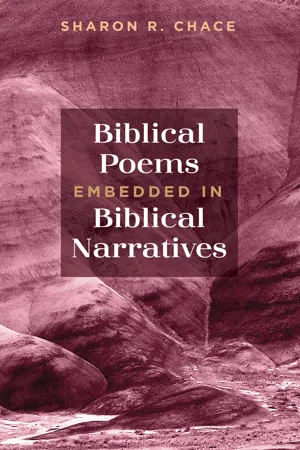![]()
Session 1
Bibical Poems Inside Prose
Welcome and Introduction
1.Each person states his or her name and where he or she lives, followed by a few sentences about oneself.
2.The leader speaks about his or her background, education, and publishing history.
3.The leader reads the introduction or, more likely, reads highlights from it. Optionally, participants may take turns reading the introduction. I am not the only person who benefits from rereading. Therefore, even if people have read the introduction previously, rereading can be beneficial.
Introducing the concept of biblical poems inside prose could be as basic as the following summary. Biblical poems that are embedded in narratives are poems that are inside, sometimes even hidden in prose. In contrast, the Psalms are poems that stand alone.
The hallmark of biblical poetry is parallelism. Parallel lines can express the same essential idea, or contrasting ideas, or lines of thought that build in meaning. Today, we will focus on two lines that are contrasting or opposing. “Foxes have holes, and birds of the air have nests, but the Son of Man has nowhere to lay his head” (Matt 8:20). These lines that describe Jesus as a wandering sage can be appreciated by people of many religious and humanist persuasions. The leader might want to read my discussions about these two lines within the introduction.
4.Questions from the group and discussion.
![]()
Session 2
Mary’s Poem
Luke 1:46–55
Reflection: General Background
Let us start with the author of Luke, who I will call Luke in regard to tradition. He presents Mary’s poem to his original audience. Therefore his summary of Mary’s ponderings was not written to us but Mary’s poem is for us. Who was Luke? Luke was an anonymous writer and editor, who specialized in salvation history. Because he was literary, thoughtful, and calm, he was well-suited to his self-assigned task of writing an orderly account of learned truths to his patron Theophilus. In Greek, Theophilus means “lover of God.”
When did Luke write and when? Luke wrote his Gospel between 85 and 90 AD. He also wrote Acts. Therefore Luke and Acts are a two-volume set that give glimpses of Luke’s themes. He most likely wrote to the churches that were influenced by Paul. Southern Greece may have been the place of composition.
Luke was concerned for the lost, poor, and lonely. It is very important to note that the Jewish system mandated concern for the poor, according to Amy-Jill Levine. Therefore, concern for the poor is rooted in Judaism, not a new development in the early church. Dr. Levine wrote the introduction to Luke in The Jewish Annotated New Testament. She said: “To regard Jesus, appropriately, as caring for women, children, the sick and the poor, embeds him within Judaism rather than separates him from it.”
Luke wrote stories to express his concerns and trusts in God that there will be reversals. In chapter 15 there are three stories that show Jesus’ concern for the lost. Luke selected these stories from his (metaphorically speaking) manuscript pile and grouped them together in a collection. Taken together they are like rich, painterly impasto, which means thick, highly textured paint. These stories are the parable of the lost sheep (vv. 1–7), the parable of the lost coin (vv. 8–10), and the parable of the prodigal son and his elder brother in the remaining verses. The story of the prodigal son is the most fully developed story and climax of this three-parable set. Clearly Luke had storytelling talents that are well-known. He used narrative to support his beliefs about the worth of all people, worthy of healing and salvation.
Yet Luke was also a poet. It takes a poet to name God, “The Author of Life” (Acts 3:15)! Poets also distill the most important meanings. As noted in the introduction, when righteous and devout Simeon took the infant Jesus into his arms, he praised God in poetry (2:29–32). Distilling the meaning of Jesus, Simeon says that Jesus is “a light for revelation to the Gentiles.” To my mind this distillation is both literary foreshadowing and prophetic proclamation.
As a poet Luke seems to have had knowledge of long-standing literary traditions that some people of his day would have known. Luke gives us a glimpse of Paul preaching in poetry to the Athenians. You might say that both Luke and Paul recommend the poem of an ancient poet to Athenians. We will see more of Paul’s poetic preaching in the next chapter. When Paul was in Athens he told the Athenians that he knew they were religious because he had found an altar to the “unknown god.” Paul went on to say that the Athenians would perhaps grope for and find God, who is not far from us. For “‘In him we live and move and have our being’; as even some of your own poets have said, ‘For we too are his offspring’” (Acts 17:28). According to the study notes in the Harper Collins Study Bible, the quotation that begins with “For, in him” may come from the sixth-century-BCE philosopher-poet, Epimenides. The phrase “For we too are his offspring” came from a third-century-BCE poet, Aratus. Luke uses the poetry his listeners would have known in order to convince them that his God is worthy of devotion. Therefore he was not afraid to use culture as a lens to view rel...
